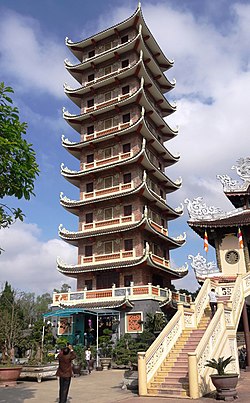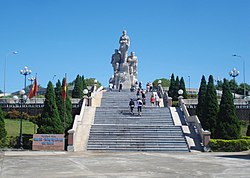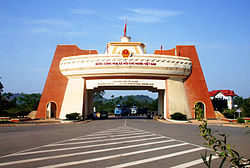Top Qs
Timeline
Chat
Perspective
Quảng Trị province
Province of Vietnam From Wikipedia, the free encyclopedia
Remove ads
Quảng Trị is a coastal province near the southernmost part of the North Central Coast region, the Central of Vietnam. It borders Huế to the south, Savannakhet of Laos to the west and the South China Sea to the east, with 75 kilometres (47 mi) of coast.
Remove ads
Geography
Summarize
Perspective

Except for the narrow piedmont coastal plains, the terrain of Quảng Trị province is dominated by hills and the Annamite Mountains.
The highlands, characterized by steep slopes, sharp crests, and narrow valleys, are covered mainly by a dense broadleaf evergreen forest. Most of the peaks are between 4,000 feet (1,200 m) and 7,000 feet (2,100 m) feet high, but some rise above 8,000 feet (2,400 m). The narrow coastal plains flanking the highlands on the east have rocky headlands and consist of belts of sand dunes and, in areas where the soil is suitable, paddy fields. From the crests that mark the drainage divide in the highlands, streams flow either east towards the South China Sea or west into Laos and Cambodia. Those flowing eastward follow short courses through deep narrow valleys over rocky bottoms until they reach the coastal plains, where they slow down and disperse. The westward-flowing streams follow longer traces, sometimes through deep canyons which are subject to seasonal flooding. The weather features a wide range of temperatures and rainfall, with hot and dry south-west winds during the Southwest Monsoon (May to September), and much cooler wet weather during the rainy season (November to mid-March). Annual average temperature is 24 °C (75 °F), but temperatures can drop as low as 7 °C (45 °F) during the rainy season.
Remove ads
History
Summarize
Perspective


In the immediate prehistorical period, the lowlands of Quảng Trị and central Vietnam as a whole were occupied by Cham peoples (Champa), speaking a Malayo-Polynesian language, and culturally distinct from the Vietnamese to the north along the Red River. The Qin dynasty of China conquered parts of present-day Central Vietnam at the end of the 3rd century BCE, and administered the indigenous peoples of the area through a commandery, Rinan, for several centuries. A rebellion by the Cham in the 2nd century CE overthrew Chinese control and reestablished local government.[4] Beginning in the 14th and 15th centuries, the Chams were defeated in the area by Vietnamese armies, and ethnic Vietnamese gradually displaced or absorbed/assimilated those Chams who had not fled. Over time a distinct Vietnamese dialectical and cultural subgroup developed in the area. The region was seized by the French by 1874. In 1887 it became part of French Indochina, i.e. the Annam protectorate.

Upon the division of Vietnam in 1954 into North and South according to Geneva accords, Quảng Trị became the northernmost province of the State of Vietnam and the Republic of Vietnam, successor of the former. The Vietnamese Demilitarized Zone lay in the province. Beginning 1964, the province gradually became a center for American bases, particularly after October 1966, when the 3rd Marine Division moved to bases just south of the demilitarized zone. In 1966, North Vietnamese forces (PAVN) also began occupying the northern region and pushing deeper into the province. The provincial capital, Quảng Trị City, was overrun and occupied briefly by Communist troops in April 1967, and was a principal battleground during the 1968 Tet Offensive when it was again overrun by North Vietnamese troops and held for a short period before being recaptured by South Vietnamese government and U.S. forces.[5][6] The Battle of Khe Sanh (1968) was a part of the North's steady efforts to occupy the whole of the province. After Khe Sanh was evacuated in July 1968, the North Vietnamese continued their efforts to take the entire province. The most notable achievement of the North Vietnamese offensive in 1972 was capturing Quảng Trị (First Battle of Quảng Trị), although they lost much of the territory gained during the South Vietnamese counter-offensive from June through September 1972 (Second Battle of Quảng Trị). In 1975, communist North Vietnamese army took over the South. Vietnam was unified in 1976.
Formerly, in 2000, Clear Path International (CPI) removed unexploded ordnance (UXO) left by the United States in Quảng Trị province, which was at the time the largest unexploded ordnance removal effort by an NGO in Vietnam's history. Since 1999, Mines Advisory Group (MAG International) has maintained operations in Quảng Trị and neighbouring Quảng Bình province, providing the only civilian staffed demining and UXO clearance operations in Vietnam.[citation needed] Slowly rebuilding in the areas cleared of mines is Roots of Peace[7] working with MAG on a demine-replant model, clearing areas and working with local farmers to plant high-value crops.
Remove ads
Administrative divisions
Summarize
Perspective
Former divisions
Quảng Trị is subdivided into 10 district-level sub-divisions until July 1, 2025:
- 8 districts:
Administrative units from July 2025
According to the Plan to arrange and merge administrative units in Vietnam 2024–2025, from July 1, 2025, the new Quảng Trị Province (including Quảng Trị and Quảng Bình) will have the following communes and wards:
- Merging the communes of Quảng Hòa, Quảng Lộc, Quảng Văn and Quảng Minh into the new commune of Nam Gianh.
- Merging the communes of Quảng Tân, Quảng Trung, Quảng Tiên, Quảng Sơn and Quảng Thủy into the new commune of Nam Ba Đồn.
- Merging the communes of Trọng Hóa and Dân Hóa into the new commune of Dân Hóa.
- Merging the communes of Hóa Sơn and Hóa Hợp into the new commune of Kim Điền.
- Merging the communes of Thượng Hóa, Trung Hóa, Minh Hóa and Tân Hóa into the new commune of Kim Phú.
- Merging the township of Quy Đạt and communes of Xuân Hóa, Yên Hóa, Hồng Hóa into the new commune of Minh Hóa.
- Merging the communes of Lâm Hóa and Thanh Hóa into the new commune of Tuyên Lâm.
- Merging the communes of Thanh Thạch and Hương Hóa into the new commune of Tuyên Sơn.
- Merging the township of Đồng Lê and communes of Kim Hóa, Lê Hóa, Thuận Hóa, Sơn Hóa into the new commune of Đồng Lê.
- Merging the communes of Đồng Hóa, Thạch Hóa and Đức Hóa into the new commune of Tuyên Phú.
- Merging the communes of Phong Hóa, Ngư Hóa and Mai Hóa into the new commune of Tuyên Bình.
- Merging the communes of Tiến Hóa, Châu Hóa, Cao Quảng and Văn Hóa into the new commune of Tuyên Hóa.
- Merging the communes of Phù Cảnh, Liên Trường and Quảng Thanh into the new commune of Tân Gianh.
- Merging the communes of Quảng Lưu, Quảng Thạch and Quảng Tiến into the new commune of Trung Thuần.
- Merging the communes of Quảng Phương, Quảng Xuân and Quảng Hưng into the new commune of Quảng Trạch.
- Merging the communes of Quảng Châu, Quảng Tùng and Cảnh Dương into the new commune of Hòa Trạch.
- Merging the communes of Quảng Đông, Quảng Phú, Quảng Kim and Quảng Hợp into the new commune of Phú Trạch.
- Merging the communes of Tân Trạch and Thượng Trạch into the new commune of Thượng Trạch.
- Merging the township of Phong Nha and communes of Lâm Trạch, Xuân Trạch, Phúc Trạch into the new commune of Phong Nha.
- Merging the communes of Thanh Trạch, Hạ Mỹ, Liên Trạch and Bắc Trạch into the new commune of Bắc Trạch.
- Merging the communes of Hải Phú (Bố Trạch district), Sơn Lộc, Đức Trạch and Đồng Trạch into the new commune of Đông Trạch.
- Merging the township of Hoàn Lão and communes of Trung Trạch, Đại Trạch, Tây Trạch, Hòa Trạch into the new commune of Hoàn Lão.
- Merging the communes of Hưng Trạch, Cự Nẫm, Vạn Trạch and Phú Định into the new commune of Bố Trạch.
- Merging the township of Nông trường Việt Trung, commune of Nhân Trạch and Lý Nam into the new commune of Nam Trạch.
- Merging the township of Quán Hàu and communes Vĩnh Ninh, Võ Ninh, Hàm Ninh into the new commune of Quảng Ninh.
- Merging the communes of Tân Ninh, Gia Ninh, Duy Ninh and Hải Ninh into the new commune of Ninh Châu.
- Merging the communes of Vạn Ninh, An Ninh, Xuân Ninh and Hiền Ninh into the new commune of Trường Ninh.
- Merging the communes of Trường Xuân and Trường Sơn into the new commune of Trường Sơn.
- Merging the township of Kiến Giang and communes of Liên Thủy, Xuân Thủy, An Thủy, Phong Thủy, Lộc Thủy into the commune of Lệ Thủy.
- Merging the communes of Cam Thủy (Lệ Thủy district), Thanh Thủy, Hồng Thủy and Ngư Thủy Bắc into the new commune of Cam Hồng.
- Merging the communes of Hưng Thủy, Sen Thủy and Ngư Thủy into the new commune of Sen Ngư.
- Merging the communes of Tân Thủy, Dương Thủy, Mỹ Thủy and Thái Thủy into the new commune of Tân Mỹ.
- Merging the communes of Trường Thủy, Mai Thủy and Phú Thủy into the new commune of Trường Phú.
- Merging the township of Nông trường Lệ Ninh, Sơn Thủy and the commune of Hoa Thủy into the new commune of Quảng Trị.
- Merging the communes of Kim Thủy, Ngân Thủy and Lâm Thủy into the new commune of Kim Ngân.
- Merging the township of Hồ Xá and communes of Vĩnh Long, Vĩnh Chấp into the new commune of Vĩnh Linh.
- Merging the township of Cửa Tùng and communes of Vĩnh Giang, Hiền Thành, Kim Thạch into the new commune of Cửa Tùng.
- Merging the communes of Vĩnh Thái, Trung Nam, Vĩnh Hòa and Vĩnh Tú into the new commune of Vĩnh Hoàng.
- Merging the communes of Vĩnh Lâm, Vĩnh Sơn and Vĩnh Thủy into the new commune of Vĩnh Thủy.
- Merging the township of Bến Quan and communes of Vĩnh Ô, Vĩnh Hà, Vĩnh Khê into the new commune of Bến Quan.
- Merging the communes of Hải Thái, Linh Trường, Gio An and Gio Sơn into the new commune of Cồn Tiên.
- Merging the township of Cửa Việt and communes of Gio Mai and Gio Hải into the new commune of Cửa Việt.
- Merging the township of Gio Linh and communes Gio Quang, Gio Mỹ, Phong Bình into the new commune of Gio Linh.
- Merging the communes of Trung Hải, Trung Giang and Trung Sơn into the new commune of Bến Hải.
- Merging the township of Cam Lộ and communes of Cam Thành, Cam Chính, Cam Nghĩa into the new commune of Cam Lộ.
- Merging the communes of Cam Thủy (huyện Cam Lộ), Cam Hiếu, Cam Tuyền and Thanh An into the new commune of Hiếu Giang.
- Merging the communes of A Bung and A Ngo into the new commune of La Lay.
- Merging the communes of A Vao, Húc Nghì and Tà Rụt into the new commune of Tà Rụt.
- Merging the communes of Ba Nang, Tà Long and Đakrông into the new commune of Đakrông.
- Merging the communes of Triệu Nguyên and the commune of Ba Lòng into the new commune of Ba Lòng.
- Merging the township of Krông Klang, communes of Mò Ó and Hướng Hiệp into the new commune of Hướng Hiệp.
- Merging the communes of Hướng Việt and Hướng Lập into the new commune of Hướng Lập.
- Merging the communes of Hướng Sơn, Hướng Linh and Hướng Phùng into the new commune of Hướng Phùng.
- Merging the township of Khe Sanh and communes Tân Hợp, Húc, Hướng Tân into the new commune of Khe Sanh.
- Merging the communes of Tân Liên, Hướng Lộc and Tân Lập into the new commune of Tân Lập.
- Merging the communes of Tân Thành (Hướng Hóa district), Tân Long and the township of Lao Bảo into the new commune of Lao Bảo.
- Merging the communes of Thanh, Thuận and Lìa into the new commune of Lìa.
- Merging the communes of Ba Tầng, Xy and A Dơi into the new commune of A Dơi.
- Merging the township of Ái Tử and communes of Triệu Thành, Triệu Thượng into the new commune of Triệu Phong.
- Merging the communes of Triệu Ái, Triệu Giang and Triệu Long into the new commune of Ái Tử commnue.
- Merging the communes of Triệu Độ, Triệu Thuận, Triệu Hòa and Triệu Đại into the new commune of Triệu Bình.
- Merging the communes of Triệu Trung, Triệu Tài and Triệu Cơ into the new commune of Triệu Cơ.
- Merging the communes of Triệu Trạch, Triệu Phước and Triệu Tân into the new commune of Nam Cửa Việt.
- Merging these the township Diên Sanh and communes of Hải Trường, Hải Định into the new commune of Diên Sanh.
- Merging the communes of Hải Dương, Hải An and Hải Khê into the new commune of Mỹ Thủy.
- Merging the communes of Hải Phú (Hải Lăng district), Hải Lâm and Hải Thượng into the new commune of Hải Lăng.
- Merging the communes of Hải Sơn, Hải Phong and Hải Chánh into the new commune of Nam Hải Lăng.
- Merging the communes of Hải Quy, Hải Hưng and Hải Bình into the new commune of Vĩnh Định.
- Merging the wards of Đức Ninh Đông, Đồng Hải, Đồng Phú, Phú Hải, Hải Thành, Nam Lý and communes of Bảo Ninh, Đức Ninh into the new ward of Đồng Hới.
- Merging the wards of Bắc Lý, Lộc Ninh and the commune of Quang Phú into the new ward of Đồng Thuận.
- Merging the wards of Bắc Nghĩa, Đồng Sơn and communes of Nghĩa Ninh, Thuận Đức into the new ward of Đồng Sơn.
- Merging the wards of Quảng Phong, Quảng Long, Ba Đồn and Quảng Hải into the new ward of Ba Đồn.
- Merging the wards of Quảng Phúc, Quảng Thọ and Quảng Thuận into the new ward of Bắc Gianh.
- Merging Ward 1, Ward 4, Đông Giang ward, and Đông Thanh ward into the new ward of Đông Hà.
- Merging Ward 2 (Đông Hà city), Ward 5, Đông Lễ ward and Đông Lương ward into the new ward of Nam Đông Hà.
- Merging Ward 1, Ward 2 and Ward 3 (Quảng Trị Town), An Đôn ward and Hải Lệ commune into the new ward of Quảng Trị.
- Reorganizing the district of Cồn Cỏ into the special administrative zone of Cồn Cỏ.
- The commune of Tân Thành remains unchanged.
Remove ads
Non-governmental organizations
Currently,[when?] there are many non-governmental organizations (NGOs) working in Quảng Trị. One of the biggest problems which they are focusing on is the explosive remnants of war (ERW). Below is the list of NGOs who are very active in helping Quảng Trị province deal with this problem:
- Clear Path International (CPI)
- Mines Advisory Group (MAG)
- PeaceTrees Vietnam (PTVN)
- Project RENEW ("Restoring the Environment and Neutralizing the Effects of the War")
- Roots of Peace[8] (RoP)
Remove ads
Transportation
The National Route 1 runs north–south of this province. Vietnam–Laos road also runs west–east of this province and has a junction with national road 1A. Hanoi–Saigon Railway goes through Quảng Trị. Air travel will be served by Quảng Trị Airport to be built 7 km north of Đông Hà and it expected to be operational from 2026. In the meantime, air travel is served by two airports in neighbouring provinces which are Đồng Hới Airport and Phu Bai International Airport in Huế.
Remove ads
Etymology
The province's name derives from Sino-Vietnamese 廣治.
Notable people
- Như Quỳnh (born 1970), singer and Quảng Trị native; now lives in the U.S.
- Thúy Nga (born 1976), actor, comedian and beauty pageant grew up in Quảng Trị; now lives in the U.S.
- Vân Khánh, (born 1978), traditional folk singer
- Minh Thùy, (born 1987), singer
- Tăng Duy Tân, (born 1995), singer
See also
References
Further reading
External links
Wikiwand - on
Seamless Wikipedia browsing. On steroids.
Remove ads





















